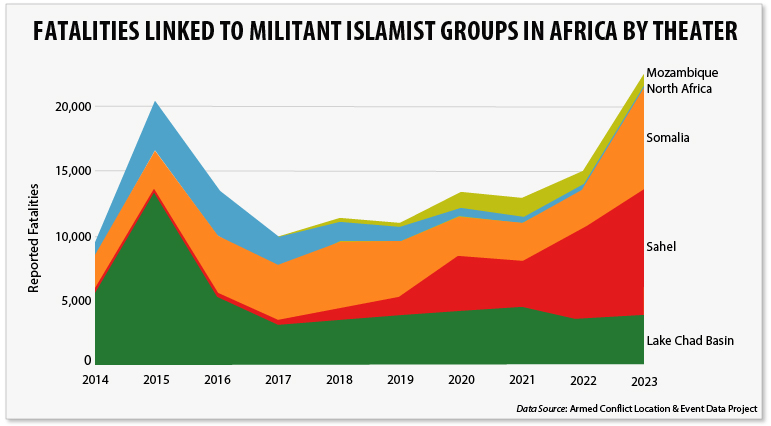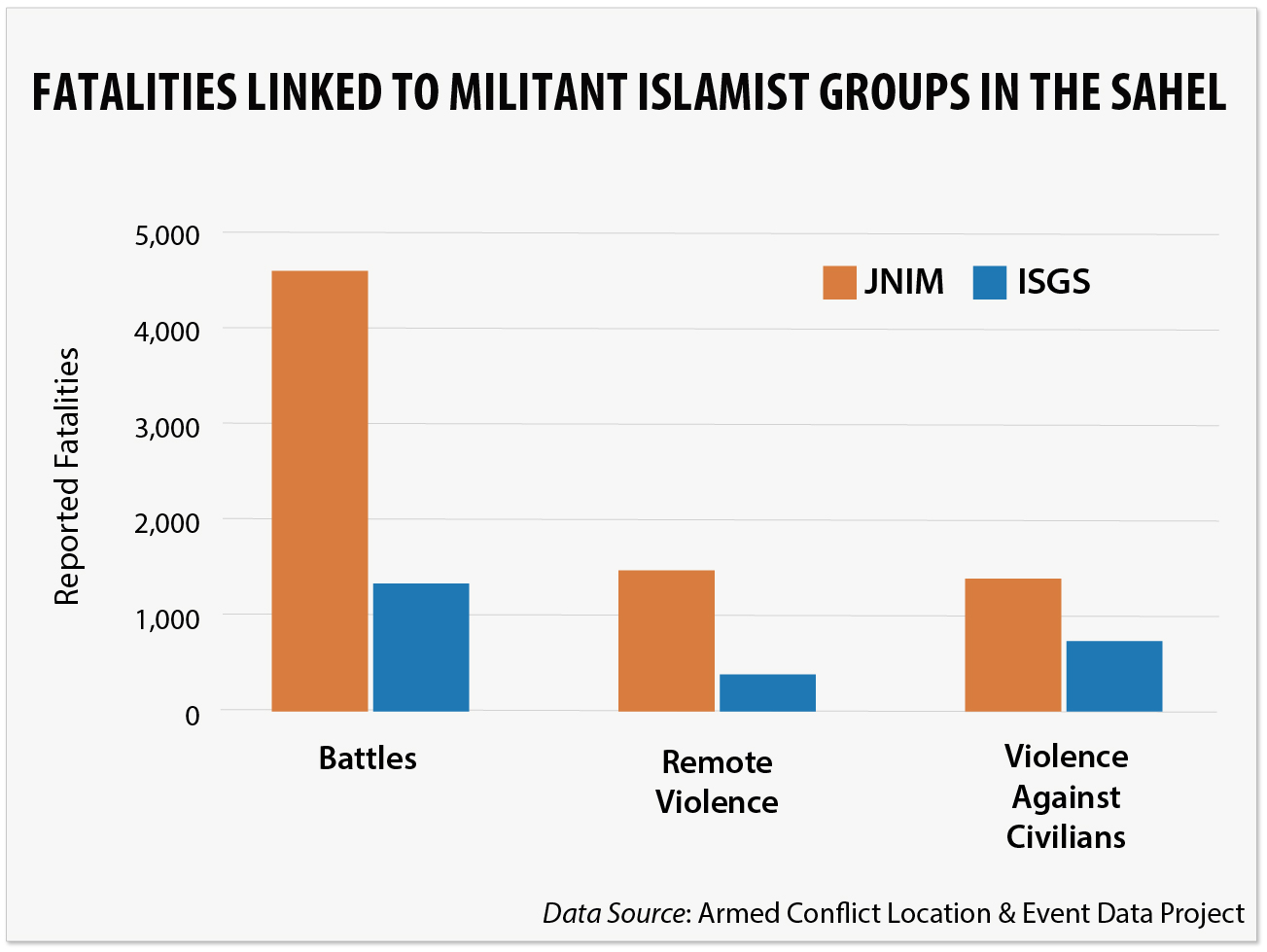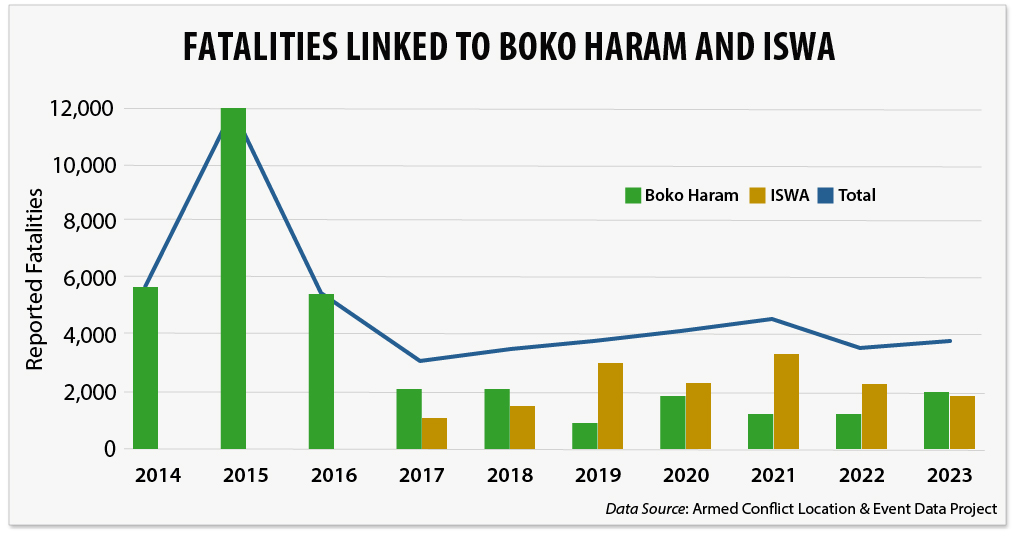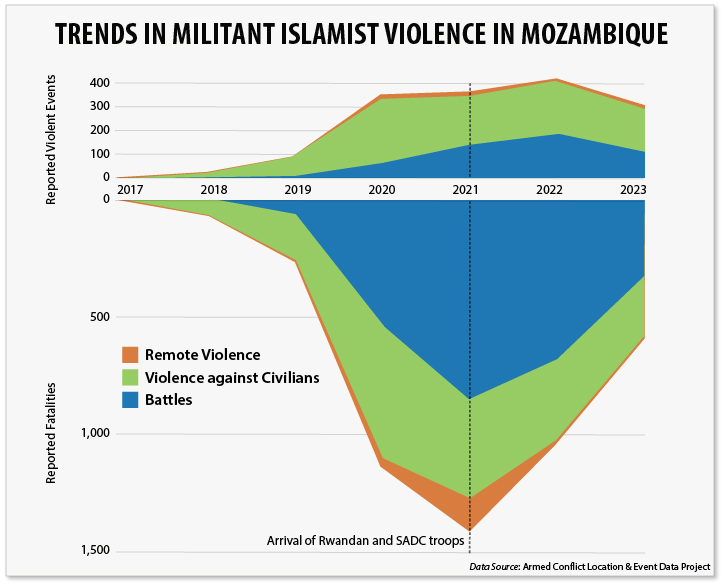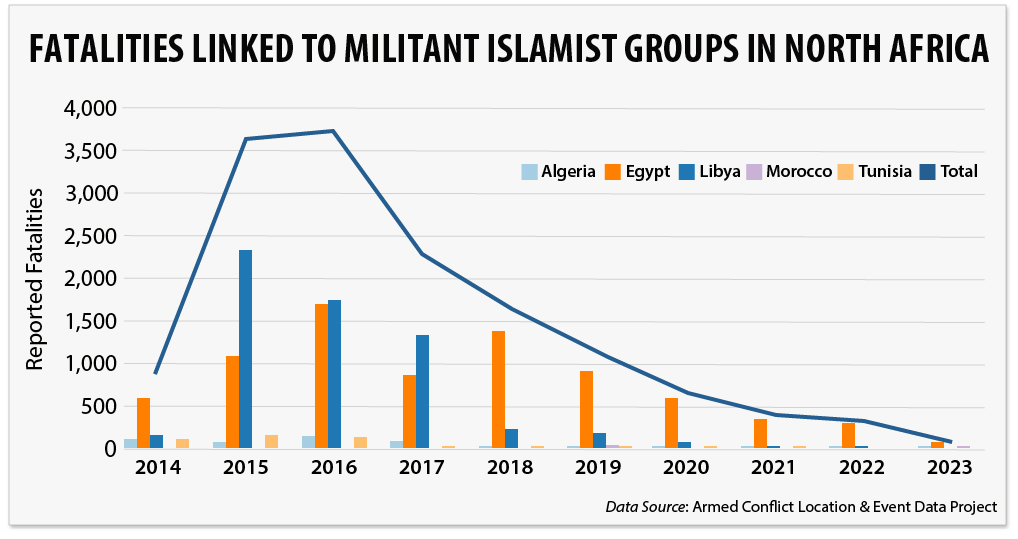Highlights
A year-on-year mid-year review of violence involving African militant Islamist groups assessing trends over the past decade underscores the surge in fatalities in the Sahel and Somalia. Key findings include:
- Fatalities linked to militant Islamist groups reached 22,288 over the past 12 months. This represents a 48-percent increase from the previous year that saw 15,024 fatalities. This level of fatalities is roughly two and a half times more than the pace experienced a decade ago and higher than the record 20,562 set in 2015, mostly driven by Boko Haram’s lethal use of violence.
“The Sahel continues to be the region experiencing the most violent events and fatalities.”
- 80 percent of these fatalities and events are happening in the Sahel and Somalia, which saw spikes in annual militant Islamist-linked deaths of 39 and 157 percent, respectively. The Sahel continues to be the region experiencing the most violent events (2,912) and fatalities (9,818).
- Significant drops in militant Islamist violence in North Africa and northern Mozambique helped moderate the continental increase in violent events, which rose 4 percent. Nonetheless, Africa has experienced a nearly four-fold increase in reported violent events linked to militant Islamist groups over the past decade (from 1,812 events in 2014 to 6,756 events in 2023). Almost half of that growth happened in the last 3 years.
- Battles have accounted for a growing share of fatalities linked to militant Islamist groups in recent years. In 2023, over two-thirds of reported fatalities (14,867) were linked to battles—the highest percentage over the past decade. Much of this can be attributed to the growing intensity of clashes in Somalia, which saw a 235-percent increase in battle-related fatalities over the past year, resulting in a reported 6,199 deaths.
Sahel
- The Sahel has seen a doubling in the number of violent events involving militant Islamist groups since 2021 (now totaling 2,912). It has also experienced a near tripling in fatalities linked to this violence in the same timeframe (to 9,818 deaths).
“87 percent of the violent events in the Sahel are concentrated in Burkina Faso and Mali.”
- 87 percent of the violent events in the Sahel are concentrated in Burkina Faso and Mali. The observed spikes in violence coincide with the military coups in those countries. It also reflects the opportunity militants seized when the Malian military junta scuttled its regional, MINUSMA, and international security partnerships, while inviting in the Russian Wagner Group paramilitary forces, who have been credibly accused of widespread human rights violations.
- Burkina Faso continues to bear the brunt of violence in the Sahel, accounting for more than 50 percent of the reported events linked to militant Islamist groups in the theater (for a second year in a row). Burkina Faso also accounts for 62 percent of all fatalities in the region. Over the past year, Burkina Faso saw an 88-percent increase in fatalities, comprising some 6,130 deaths.
- The Sahel has held the dubious distinction of the theater with the most attacks on civilians for the last 3 years. In 2023, there were over 1,100 attacks on civilians by Sahelian militant Islamist groups causing more than 2,080 fatalities—that is 59 percent of all such attacks on civilians by militant Islamist groups in Africa, and 68 percent of the linked fatalities.
- There were almost an equal number of attacks on civilians as battles over the past year, with battles accounting for 60 percent of all fatalities in the region. Meanwhile, fatalities linked to remote violence (mainly IEDs) surged by 61 percent in the past year.
- Most of the battle escalation and fatalities appear to be linked to the groups of the Jama’at Nusrat al Islam wal Muslimeen (JNIM) coalition. In Mali, with the departure and drawing down of the Barkhane and MINUSMA forces, Mopti saw a 37-percent increase in fatalities. Gao, where JNIM and the Islamic State in the Greater Sahara (ISGS) have been fighting to control, saw a 40-percent increase.
- Niger represents 8 percent of the total number of violent events in the Sahel in the past year. Due to the withdrawals of the Barkhane and MINUSMA forces in Mali, there has been an increase of ISGS violence along the Nigerien border. Nonetheless, Niger saw a 54-percent decrease in fatalities over the past year, most of which were battle-related.
- It should be noted that with the surge in violence and fatalities in the Sahel theater, the military juntas in both Mali and Burkina Faso have been restricting press freedoms and limiting or denying access to foreign actors that provide both security and humanitarian assistance. As a result, reported violent events and fatalities linked to Mali and Burkina Faso are probably an undercount.
“Benin and Togo have each experienced a dramatic rise in violent events.”
- Benin and Togo have each experienced a dramatic rise in violent events over the last year (to 131 from 16 in Benin, and to 22 from 3 in Togo). This represents a combined eight-fold increase in violent events. What was previously seen as episodic spillover from Burkina Faso into West Africa’s littoral states has become an ongoing security threat in these countries. Benin and Togo experienced 140 and 98 reported fatalities as a result of this violence in the past year, respectively.
Somalia
- Somalia experienced a striking 157-percent increase in fatalities linked to al Shabaab over the past year, resulting in 7,937 deaths. This represents a record level of fatalities in Somalia over its 17-year existence, far surpassing the previous high point of 5,224 deaths in 2018.
- Somalia accounted for 36 percent of all militant Islamist-related fatalities on the continent this past year, making it the second most active theater (after the Sahel). This percentage is roughly where Somalia has been for the last 4 years, which is a decline from the first part of the decade where it was, on average, linked to more than 50 percent of all militant Islamist activity in Africa.
- Somalia saw a 235-percent increase in battle-related fatalities over the past year (to 6,199 deaths). This year, battle-related fatalities comprised 78 percent of all fatalities linked to Somalia. This marks an increase from the 63 percent average over the last decade.
- In August of 2022, the newly elected President Hassan Sheikh Mohamud called for a joint offensive with clan militias and international forces, including ATMIS, against al Shabaab. The spike in battle related fatalities reflects this offensive and the retaliatory attacks by al Shabaab.
“The past year also saw a 71-percent increase in al Shabaab-linked fatalities against civilians.”
- The past year also saw a 71-percent increase in al Shabaab-linked fatalities against civilians. Though violence against civilians tends to be the least common tactic by al Shabaab, this spike may reflect the greater pressure al Shabaab fighters are facing from the joint offensive, with some fleeing across the Kenyan border and now attacking civilians. In an attempt to maintain intimidation over local communities, al Shabaab has also assassinated prominent sheikhs and lawmakers who have criticized the militant group.
- This past year also saw periodic al Shabaab forays into Ethiopia. While infrequent, this violence has resulted in 214 fatalities, a marked escalation from the previous year. While Kenya faces a more sustained rate of violent events from al Shabaab along its border than Ethiopia, fatalities in Kenya have declined to 125.
Lake Chad Basin
- After a sharp drop in reported violent events and fatalities in 2022, the Lake Chad Basin saw a renewed increase in activity (17 percent) and fatalities (9 percent) this past year, bringing militant Islamist violence back to 2019 levels.
- The 986 reported events are largely attributed to a resurgent Boko Haram. There was a 57-percent increase in activity tied to Boko Haram. By contrast, there was a 5-percent decrease in events associated with the Islamic State in West Africa (ISWA).
- The 3,859 reported fatalities over the past year represent a 63-percent increase in activity linked to Boko Haram and an 18-percent decrease attributed to ISWA. The two groups are now roughly equivalent in terms of the number of associated fatalities in the Lake Chad Basin.
- While 50 percent of militant Islamist violence in the Lake Chad Basin is in Nigeria, Cameroon, Niger, and Chad all saw increases in the frequency of this violence over the past year. Cameroon stood out with a 51-percent increase in violent activity, comprising 351 events. Despite these increases, 82 percent of fatalities in this theater are in Nigeria.
“Violence against civilians was the second most frequent tactic used by both groups.”
- Boko Haram expanded its violent activities across battles, violence against civilians, and remote violence. Battles made up the majority of events linked to both Boko Haram and ISWA. Both groups have also been actively fighting each other since the death of Boko Haram’s leader, Abubakar Shekau, in 2021.
- Violence against civilians was the second most frequent tactic used by both groups. Attacks on civilians contributed to 43 percent of the violent events linked to Boko Haram, and 29 percent to ISWA. Long relying on predation, Boko Haram cells have taken advantage of civilian vulnerability to enrich themselves.
Mozambique
- The Ahlu Sunnah wa Jama’a (ASWJ) insurgency, which started in October of 2017 and quickly escalated, began to slow down with the arrival of Southern African Development Community (SADC) and Rwandan security forces in July of 2021. The continued presence of the forces has led to even more substantial drops in activity and fatalities linked to the militant group.
- For the first time since emerging on the scene, reported violent events linked to ASWJ dropped by 27 percent, and fatalities dropped by 43 percent. The 301 events and 596 fatalities reported for 2023 are the lowest Mozambique has seen since 2019.
- This represents a decline both in the frequency of battles and violence against civilians.
- The 20-percent drop in the number of attacks on civilians (to 171 events) is particularly noteworthy. Violence against civilians has always been a distinguishing feature of ASWJ (representing about 71 percent of ASWJ events on average). Related fatalities have dropped by 25 percent (to 261).
North Africa
- Continuing a downward trend observed since 2015, militant Islamist activity and related fatalities in North Africa dropped more than 75 percent over the past year. This equates to 51 violent events and 78 fatalities. The theater now contributes just 1 percent of militant Islamist activity and less than 1 percent of the related fatalities.
- The steady decline in violence reflects a combination of factors. In the latter half of this decade, the majority of militant Islamist violence took place in Egypt. It had already diminished significantly elsewhere, not least because of a lack of support by the civilian population (e.g., Algeria and Libya). Even in Tunisia, which had the largest group of citizens leave to fight for ISIS in Iraq and Syria, there was little support for such militant Islamist groups at home. Like Egypt and Algeria, Tunisia put considerable effort into quashing the militant Islamist groups that did appear.


